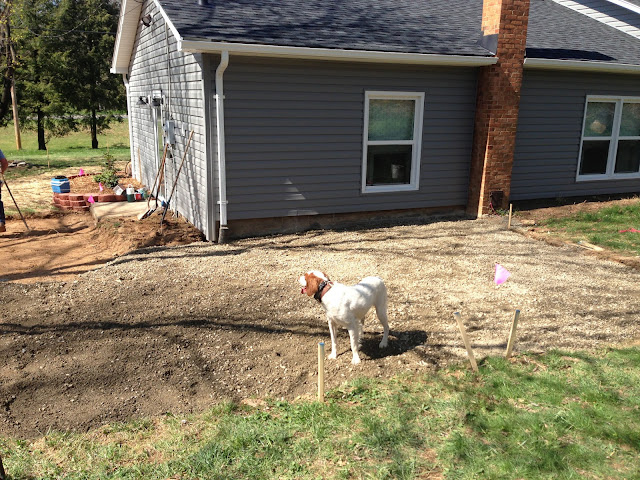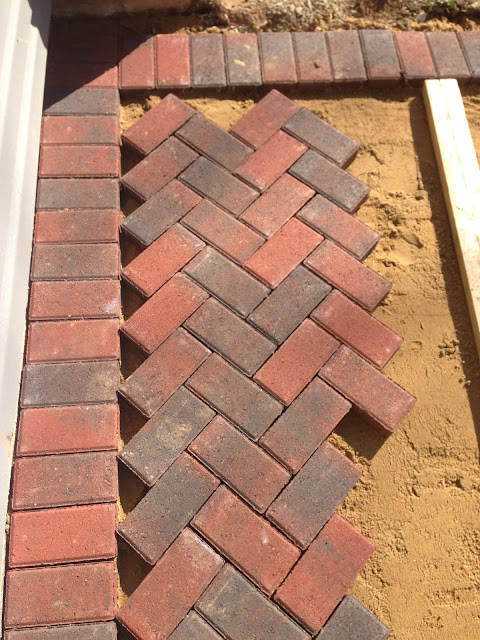Yikes. The deck wasn't in the best shape so one of the first projects back in the fall was demolishing it. So after demolishing what was there we had a yard of mud and rocks through the winter...
I ended up loving the look of brick paver patios. The downside of course is the sheer number needed to cover the area since they are so small-we ended up needing around 2100 brick pavers (that's around 8,000 lbs of pavers!) The next decision was the pattern to lay the bricks in...Matt was all about simplicity and would have preferred simply running the bricks but I loved the classic/historic look of a herringbone pattern.
Later that evening we went for supplies...we had to take several trips because the pallets of bricks were so heavy and we ended up needing 3 pallets (about 700 bricks were in each pallet). We also learned that when you are buying in bulk like this it doesn't hurt to ask if Lowes or Home Depot will give you a discount, we worked with Lowes and were pleasantly surprised that they were so flexible!
The next day we started laying the bricks. Before laying the bricks we spread sand over top of the gravel and tried to make the base as level as possible. This tutorial was helpful in explaining the basic process of laying herringbone bricks. Once you get started the pattern is simple to follow. This pattern did require a good bit of cutting along the edges of the patio.
After you get the first row lined up the next rows fall right into place...
The last step is to spread sand over the patio & sweep the sand into the cracks between the bricks to stabilize the patio and then spray down the patio with water (and repeat). Here are a few pictures of the patio as it is now but I won't call it finished quite yet. We still plan on building a retaining wall around the back edges and making a fire pit but the difficult part is behind us!
xo,
Steph














Brick made patio is just good enough. Carry on making this. If you need more innovative idea for making paver driveways then you can contact with Pietro Pannella Contracting. They have more good ideas in this aspect.
ReplyDeleteOne of the easiest way to improve your outdoor area is installing patio pavers and you can make a landscaping pattern through out of it. I also recommend http://www.coloradogreenlandscaping.com to get more ideas about landscaping.
ReplyDeleteHi,
ReplyDeletePatio pavers.Excellent photos and explanation. i'd felt overwhelmed wanting to install huge fussy pebble mosaic patios and paths, and you combined less pricey materials with sections of pebbly goodness. and thank you.
Thanks for posting these pictures! I really like how you used the herringbone brick pattern for your patio. I'm working on a patio right now. I think I would like the running pattern for my patio.
ReplyDeletehttp://www.sterlinglandscape.com/residential-landscape.shtml
It looks like a lot of hard work but the result is very good.
ReplyDeleteFind outdoor pavers
ReplyDeleteAt Gaiastone we take great pride on the values we bring into work; we are passionate about natural stone, and we are also passionate about our environment. In fact, our name, Gaiastone, means Stone from the Earth.
http://www.gaiastone.com.au/
Great job, almost looks like a professional has done the work. I would suggest Haunching around the edges to stop the pavers from moving. This can be done by digging a small trench and running some concrete along the edge.
ReplyDeleteI have included a link to my companies gallery page to give yourself and others some more ideas
https://www.bestgroup.com.au/gallery
Great job, almost looks like a professional has done the work. I would suggest Haunching around the edges to stop the pavers from moving. This can be done by digging a small trench and running some concrete along the edge.
ReplyDeleteI have included a link to my companies gallery page to give yourself and others some more ideas
https://www.bestgroup.com.au/gallery
Man, I have so many questions to ask I don’t know where to start. I want to attach a paver patio to my concrete porch but I’m torn between the easy (rectangular) and more complicated (free form) designs. I’ve never attempted anything like this so what advice can you give me ? Also, I am foregoing the crushed stone approach for the new “paver pads that have become popular.
ReplyDeleteMasonry Repair Brooklyn